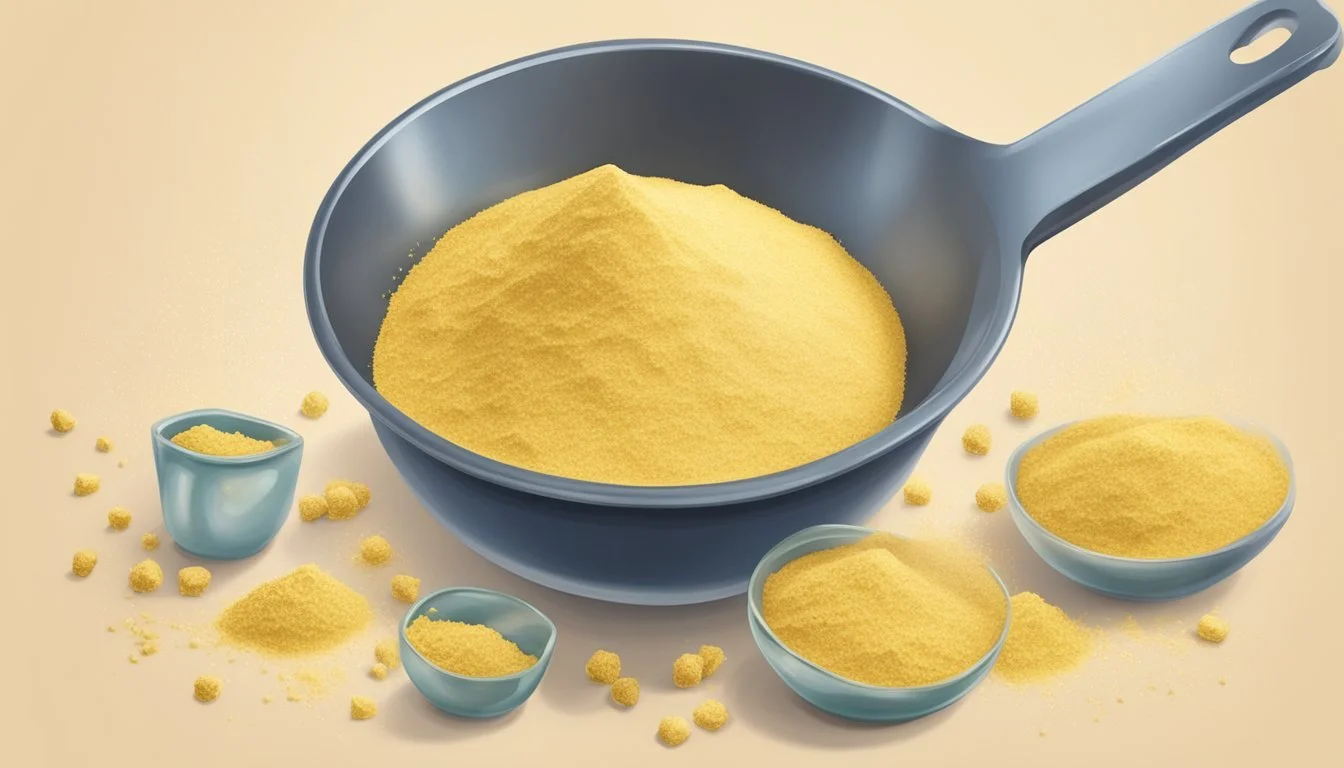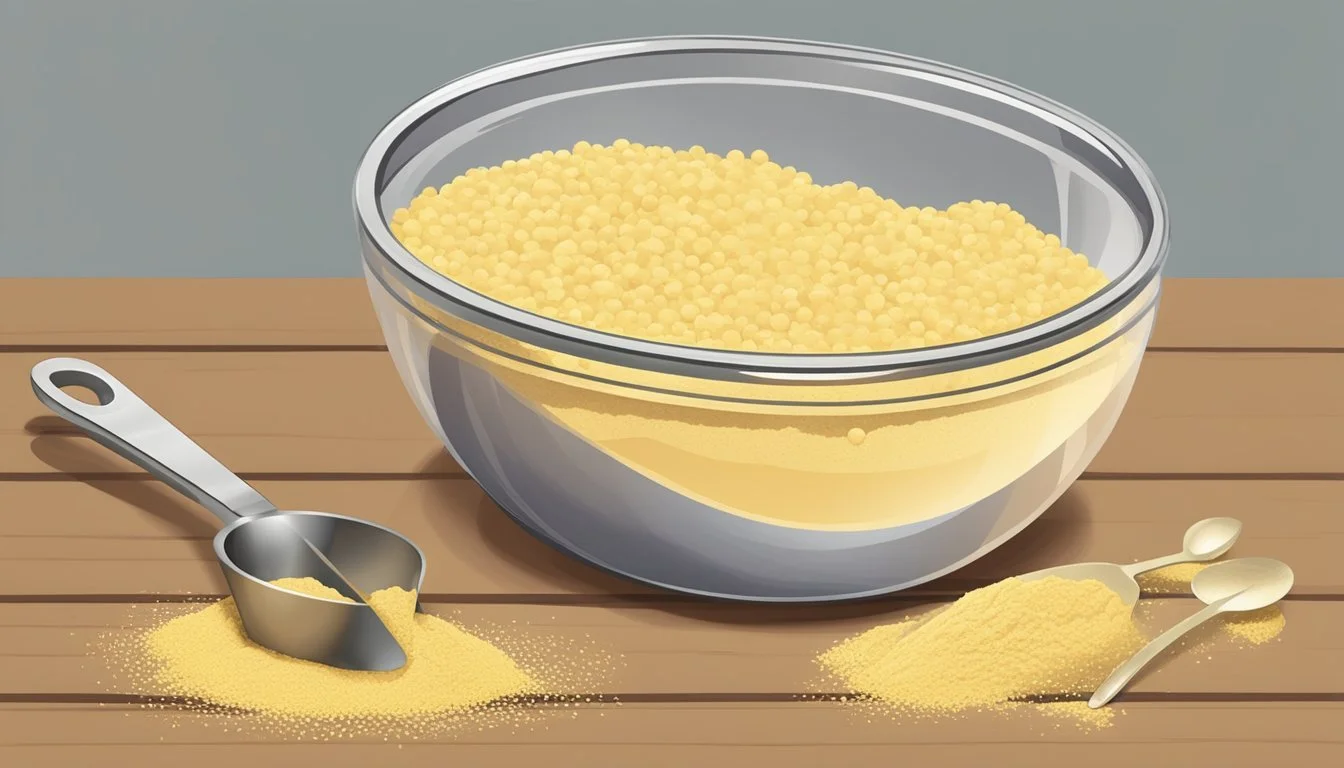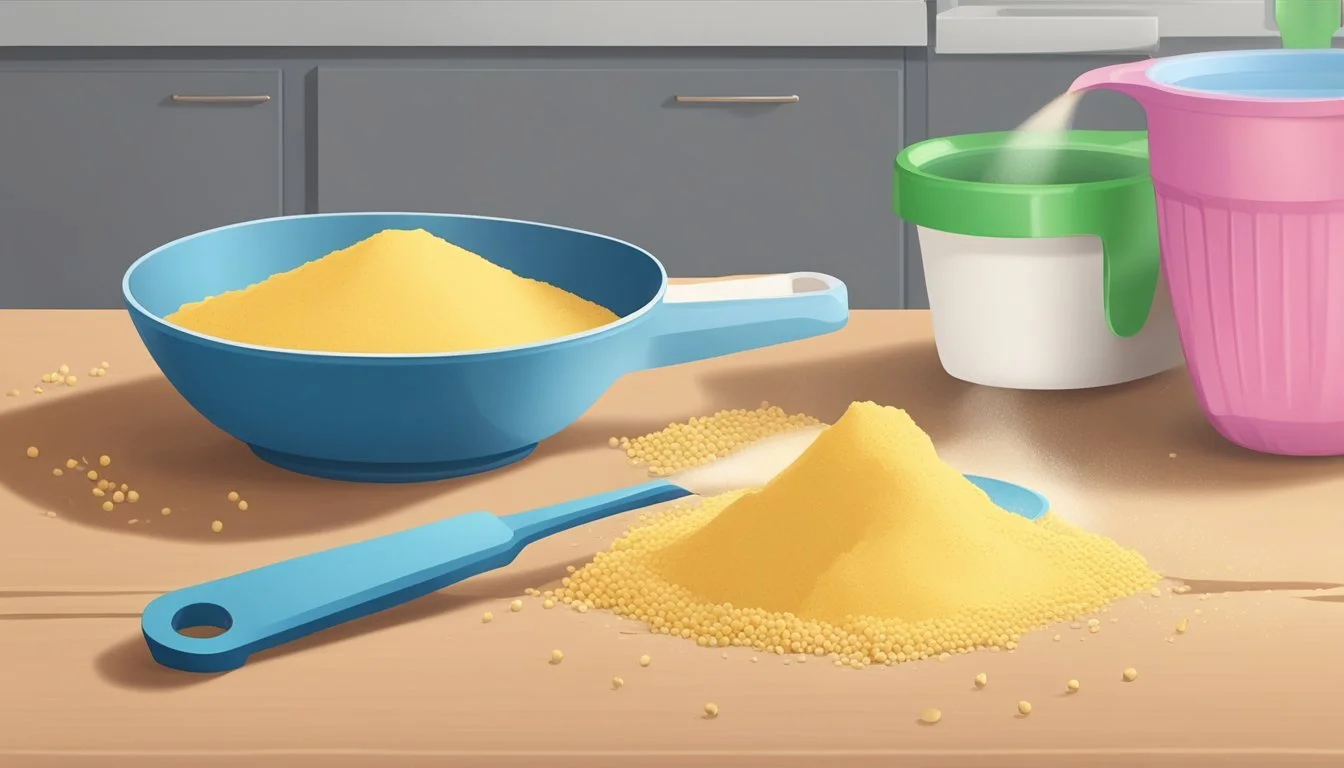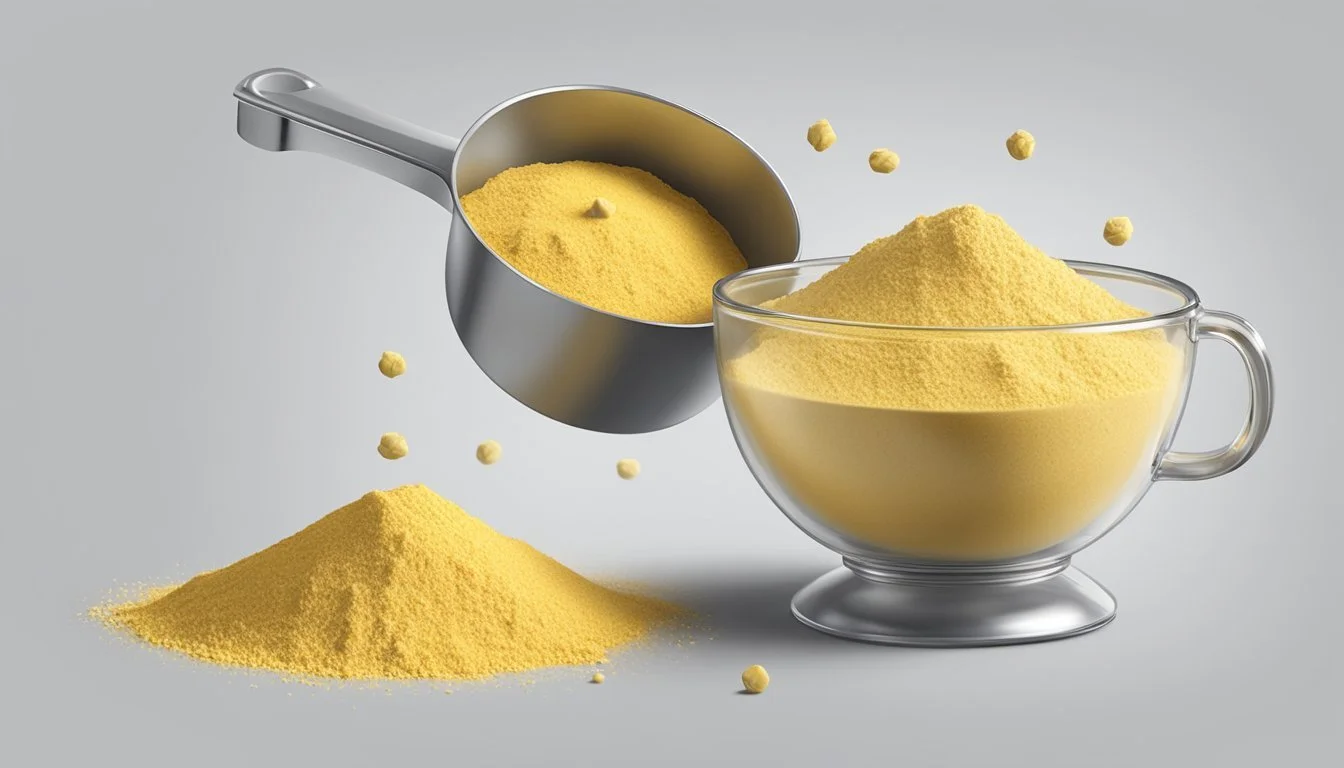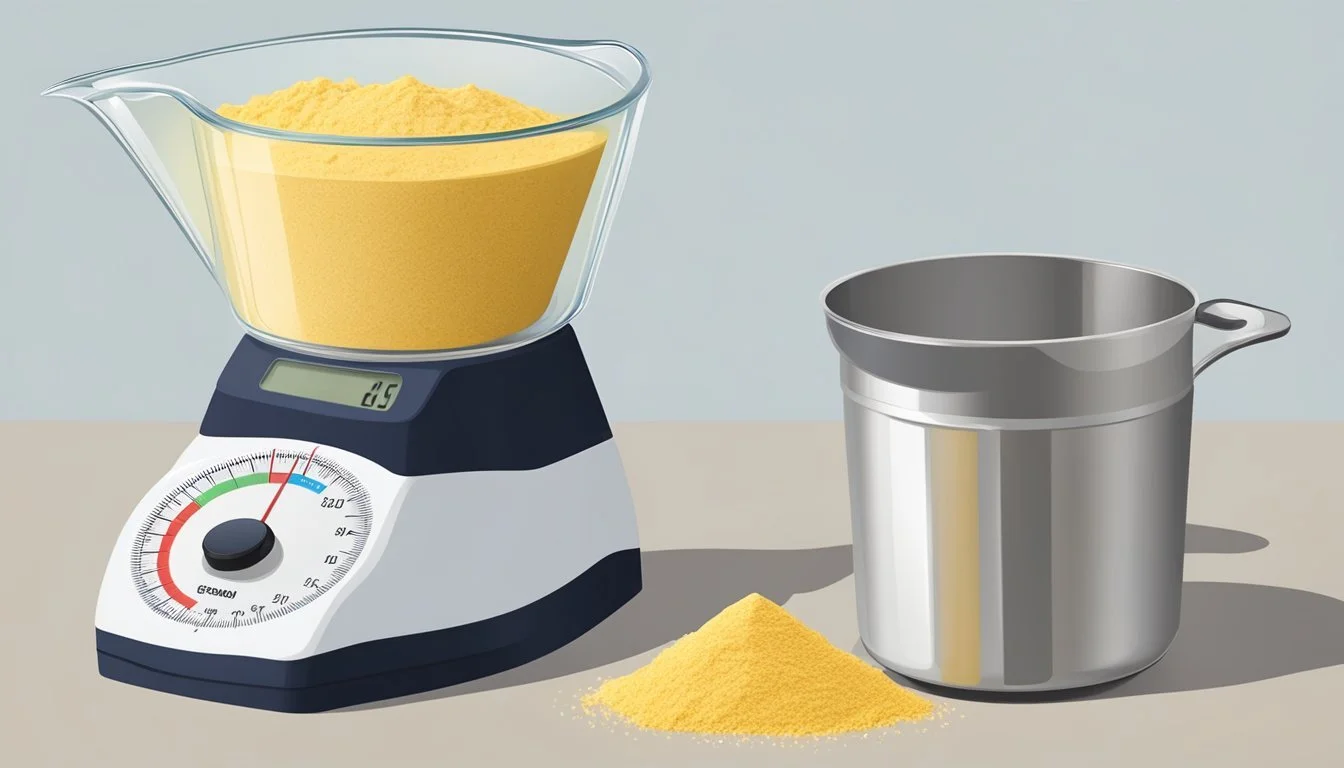How Many Tablespoons in a Pound of Chickpea Flour
Accurate Measurement Guide
Understanding the conversion of weight to volume is essential when working with ingredients such as chickpea flour, especially in culinary practices where precision matters. Chickpea flour, known for its high protein content and versatility, is a staple in many diets and is often measured in pounds for larger recipes or bulk storage. However, when specific recipes require smaller quantities, knowing the equivalent measurement in tablespoons is incredibly useful.
There is, however, some variance in the number of tablespoons in a pound of chickpea flour due to factors like settling, moisture content, and the grind's fineness. On average, a pound of chickpea flour is equivalent to approximately 51 to 79 tablespoons. This range accounts for different sources that provide varying conversions based on their own measurements and standards. It is recommended for those seeking precision to measure chickpea flour by weight when following a recipe.
Understanding Chickpea Flour
Chickpea flour, also known as gram flour or besan, is a gluten-free flour made by grinding dried chickpeas (garbanzo beans). Renowned for its fine texture and high nutritional value, it is an excellent source of protein, fiber, and a variety of vitamins and minerals.
To make homemade chickpea flour, one typically dries and grinds the chickpeas using a food processor, blender, or spice grinder. The process yields a powdery flour that exhibits a pale yellow hue. Because garbanzo beans are legumes, chickpea flour retains the nutritious qualities of its source, making it a favorite in health-conscious and gluten-free cooking.
Nutritional Profile:
Protein: A strong source for vegetarians and vegans.
Fiber: Contributes to digestive health.
Iron: Essential for oxygen transport in the body.
Magnesium: Supports muscle and nerve function.
Folate: Key for cell growth and metabolism.
Chickpea flour's versatility extends beyond its use as a gluten-free substitute for wheat flour. In cuisine, it's frequently used to create savory pancakes, fritters, and Indian dishes.
Preparation Tips:
Soak chickpeas overnight before grinding.
Dry the chickpeas thoroughly to ensure a fine powder during grinding.
Sift the ground flour to remove any larger, unprocessed pieces.
Storing chickpea flour in an airtight container ensures it remains fresh. Its shelf life can extend up to two months, maintaining its rich flavor and nutritional benefits.
Measurement Conversions
Converting pounds to tablespoons is essential for accurate ingredient measurements, particularly when dealing with chickpea flour in recipes. A precise unit conversion helps ensure the consistency and success of a dish.
The standard weight to volume conversion for chickpea flour indicates that one pound (lb) is equivalent to approximately 51.1 US tablespoons (tbsp). This approximation is based on the US customary system of measurement, commonly used in the household cooking context. Here is a simplified conversion table for common increments of chickpea flour from pounds to tablespoons:
Pounds of Chickpea Flour (lb) US Tablespoons (tbsp) 0.25 (1/4 lb) ~12.78 0.50 (1/2 lb) ~25.55 0.75 (3/4 lb) ~38.33 1 (1 lb) ~51.1 1.5 (1 1/2 lbs) ~76.65
These conversions are typical for chickpea flour, which can have slight variances in density based on factors like brand, grind consistency, and environmental humidity. For culinary teaching and diet planning where precise measurements are crucial, referencing a specific brand's measurement guidelines or using a kitchen scale can ensure greater accuracy.
It should be noted that tablespoons as a volume unit and pounds as a weight unit measure different aspects of ingredients, so conversions between the two rely on the density of the ingredient. Chickpea flour’s relatively consistent density facilitates these conversions. When measuring, one should always level the tablespoon for a reliable measure. For other ingredients or finer conversions, one might prefer to use other units, such as grams or ounces, and their corresponding volume equivalents.
Culinary Uses of Chickpea Flour
Chickpea flour showcases versatility and health benefits, becoming an essential ingredient in various culinary practices from baking to deep-frying.
Baking With Chickpea Flour
Chickpea flour is often used in gluten-free baking, serving as an alternative to wheat flour. Its binding properties make it suitable for making cakes, cookies, and muffins. For instance, it's common in sourdough breads where it not only aids in the texture but also enriches the bread’s nutritional profile.
Cooking With Chickpea Flour
In regular cooking, chickpea flour can be employed to craft pizza bases, thicken sauces, or create a batter for pancakes. Its role is key for many vegan dishes, providing structure and substance where eggs or dairy would traditionally be used.
Chickpea Flour in International Cuisine
Chickpea flour, known as gram flour or besan in Indian cuisine, is indispensable in making pakoras, falafel, and regional specialties like socca from France or Italy’s farinata. These dishes illustrate the global embrace of chickpea flour in culinary arts.
Speciality Cooking and Alternatives
When specialty diets call for alternatives to traditional flours, chickpea flour serves as a substitute to almond flour, oat flour, and others. Its gluten-free nature serves people with gluten intolerance, while providing a protein-rich, vegetarian option.
Chickpea Flour as a Diet Staple
Chickpea flour is not merely a substitute but can be the cornerstone in a diet, particularly for vegans and vegetarians. Its nutritional benefits, including protein and fiber, make it a dietary staple for many seeking healthy alternatives.
Chickpea Flour in Sweet Dishes
The nutty flavor of chickpea flour can enrich sweet dishes like cakes and brownies, providing an interesting flavor and texture profile. It is also used in a variety of dessert recipes, where it can make the end product more satiating.
Deep-Fried Delights With Chickpea Flour
Chickpea flour is the preferred choice for deep-fried items such as pakoras. It offers a crisp texture upon frying and is a staple in many cultures' deep-fried delicacies due to its ability to adhere to foods without the addition of gluten.
Egg Replacement Options
For those pursuing vegan cooking, chickpea flour mixed with water can act as an egg replacement, serving as a binding agent in various dishes. This technique is particularly useful in vegan baked goods where egg is traditionally a key ingredient.
Health and Nutrition Information
Chickpea flour, a staple in many diets, is dense in nutrients and provides a wide range of health benefits. In terms of protein, it serves as an excellent plant-based source. The flour is notably high in fiber, promoting digestive health and aiding in maintaining blood sugar levels.
Chickpea flour's nutritional value is impressive. A serving size, which typically contains fewer calories than traditional wheat flour, is rich in complex carbohydrates. These carbohydrates provide sustained energy without the rapid spike in blood sugar associated with simple sugars.
Nutrient Amount per 100g Protein 22% of DV Fiber 10.8g Carbohydrates 57.8g Manganese 74% of DV Folate 101% of DV Copper Significant Iron 25% of DV Magnesium 36% of DV
It is also abundant in minerals such as manganese, vital for bone development and wound healing, and folate, an essential nutrient for DNA synthesis and repair. Additionally, chickpea flour contains copper and iron, supportive of healthy red blood cells and overall cardiovascular health.
Regarding vitamins, chickpea flour encompasses a significant amount of Thiamin and other B-vitamins, contributing to better brain and nervous system function.
Chickpea flour integrates easily into various dishes, addressing diverse dietary needs. Due to its nutrient density and associated health benefits, it is an excellent addition to any diet, particularly for those seeking to increase their intake of plant-based proteins and fibers without sacrificing flavor or texture.
Practical Tips and Tricks
When measuring chickpea flour, precision is vital. To convert whole chickpeas to chickpea flour, one should ensure they have a high-speed blender or food processor. They must blend the chickpeas until a fine powder is achieved, which may require stopping intermittently to stir the contents for an even grind. It's crucial to then sieve the flour through a fine-mesh sieve or flour sifter, discarding any large particles.
Storing Chickpea Flour:
Airtight Container: Chickpea flour must be kept in an airtight container to prevent moisture penetration and preserve freshness.
Label: Mark the container with the current date to keep track of the shelf life.
Shelf Life: Properly stored chickpea flour can last several months. If any off smell or discoloration occurs, it’s advisable to discard the flour.
Here's a quick reference on how to store chickpea flour:
Storage Tip Description Airtight Container Keeps the flour dry and prevents insect infestation Label with Date Helps track how long the flour has been stored Cool, Dry Place Preserves the flour's integrity and extends shelf life
When working with a recipe, cooks might require conversion information. Since one pound of all-purpose flour roughly equates to 3.5 cups, using a similar density for chickpea flour is beneficial as a starting point before adjusting as needed for recipes requiring utmost precision.
One should remember that chickpea flour is denser than all-purpose flour; thus, a pound of chickpea flour may yield slightly fewer tablespoons depending on its compaction and moisture content. Always lightly spoon the flour into the measuring cup and level it off for the most accurate measure.
Chickpea Flour FAQs
Chickpea flour, also known as besan or gram flour, is a gluten-free alternative to wheat flour, made by grinding dried chickpeas into a fine powder. Individuals often have questions regarding measurement conversions, especially when adapting recipes. Below are some frequently asked questions (FAQs) about chickpea flour.
How many tablespoons are there in a pound of chickpea flour?
One pound of chickpea flour translates to approximately 51.1 US tablespoons.
Is chickpea flour the same as regular flour?
No, chickpea flour is gluten-free and has a different taste and texture compared to regular wheat flour.
Can chickpea flour be used as a direct replacement for wheat flour?
Due to its unique properties, chickpea flour cannot always be used as a 1:1 substitute for wheat flour. It's best used in recipes specifically developed for it, or adjustments may be needed.
How should chickpea flour be stored?
For optimal freshness, chickpea flour should be kept in an airtight container and can be stored for up to two months.
Is chickpea flour suitable for those with celiac disease?
Yes, chickpea flour is inherently gluten-free and safe for individuals with celiac disease. However, one should ensure it hasn't been cross-contaminated with gluten-containing ingredients.
What are common uses for chickpea flour?
Chickpea flour is versatile and used in various dishes like pancakes, fritters, flatbreads, and as a thickener for soups and sauces.
By addressing these inquiries with clear and reliable information, the aim is to assist individuals in confidently incorporating chickpea flour into their cooking and baking practices.
Associated Risks and Considerations
For individuals managing gluten intolerance or celiac disease, chickpea flour offers a safe alternative to wheat flour as it is naturally gluten-free. However, they should be vigilant about cross-contamination, especially when purchasing from facilities that also process wheat or other gluten-containing grains.
Diabetes patients may benefit from the lower glycemic index of chickpea flour compared to regular flour, but they should still monitor their carbohydrate intake. Chickpea flour is high in carbs, despite its high fiber content which can help with blood sugar regulation.
Those with allergies to legumes should be cautious; chickpeas are legumes and chickpea flour could trigger an allergic reaction. Symptoms can range from mild to severe, and consumers with legume allergies need to read labels carefully to avoid chickpea flour.
Regarding food safety, chickpea flour should be stored properly to prevent spoilage. Users should keep it in a cool, dry place, and once a package is opened, it may be stored in an airtight container to extend its shelf-life and maintain its freshness.
It’s essential for consumers to adhere to dietary considerations according to their individual health needs and consult with healthcare providers when incorporating chickpea flour into their diet, whether it is used for its nutritional benefits or as a dietary requirement.
Additional Insights
When measuring out chickpea flour in the kitchen, chefs often need to convert weight to volume. Culinary converters are instrumental for accurate recipe formulation, especially when dealing with dense ingredients like chickpea flour.
In a typical conversion, one pound of chickpea flour translates to:
51.1 US tablespoons (approximately 51 1/4 tablespoons)
78.89 US tablespoons (as per alternative conversion standards)
These two common conversions demonstrate that the actual volume can vary depending on the reference used. This is crucial for chefs, especially those in culinary education or when adapting recipes for dietetic needs, where precision is key.
Insurance for the master chef is not directly related to the conversion process but having comprehensive coverage can protect against accidents in the kitchen. When handling large quantities of flours and using equipment to convert or process chickpea flour, chefs should be aware of the risks and ensure they are sufficiently insured.
As for oven building, precision in measurements extends beyond ingredients to the actual oven dimensions and heat distribution. This precision impacts how well a dish is cooked, which is particularly significant for those looking to construct their own pizza ovens. Consistent temperature and heat retention are vital qualities that an oven must possess to ensure the proper baking of pizza crusts made from various flours, including chickpea flour.
In summary, the conversion from pounds to tablespoons of chickpea flour illustrates the importance of accuracy and consistency in cooking, which has broader implications for a chef's craft, from recipe accuracy to equipment reliability.
Regional Availability
Chickpea flour, also known as garbanzo bean flour, besan, or gram flour, is a staple ingredient in various cuisines and hence, its availability can differ by region. In Canada, chickpea flour is frequently found in bulk food stores, organic health shops, as well as in the international aisle of many major supermarkets. This is reflective of Canada's diverse population and the country's embrace of multicultural food products.
Moving to the United States, specifically Florida, the trend seems to align with the broader North American market. Florida, being a state with a warm climate, does not have an environment conducive to growing chickpeas, which typically flourish in more arid climates. However, Florida's large grocery stores, health food outlets, and specialty food shops often stock chickpea flour due to its popularity in gluten-free and protein-rich diets.
Regional differences in chickpea flour availability can be somewhat pronounced, influenced by local dietary preferences and agricultural practices. In regions where chickpeas are grown, like certain parts of Canada, one might find fresher and possibly more cost-effective chickpea flour. Conversely, in areas less known for chickpea production, such as Florida, availability might rely on imports, which could affect product freshness and price points.
In summary, shoppers can generally find chickpea flour in a variety of stores, with some variations in cost and freshness depending on regional agricultural practices and import dynamics.
Homemade Chickpea Flour Guide
Creating chickpea flour at home is a simple and cost-effective way to produce a versatile ingredient used in various recipes. Proper storage is crucial to maintain its freshness and extend its shelf life.
How to Make Chickpea Flour at Home
To prepare homemade chickpea flour, one needs dried chickpeas and a high-speed blender or food processor. To start, dried chickpeas are thoroughly rinsed to clean any debris and then dried completely. The dried chickpeas are then placed into a high-speed blender or food processor. The appliance is run until the chickpeas are ground into a fine powder.
Step 1: Place dried chickpeas in a blender or food processor.
Step 2: Process until finely ground into a powder, approximately 2 minutes, pausing to stir if necessary.
Step 3: Pass the ground chickpeas through a sieve to remove any large or coarse particles.
If any large pieces are left behind, they should be ground again until the desired consistency is achieved.
Storing Homemade Chickpea Flour
Once the chickpea flour is made, it needs to be stored properly to retain its quality. An airtight container is ideal to prevent moisture and pests from spoiling the flour.
Label: Clearly label the container with the contents and date of production.
Shelf Life: Homemade chickpea flour can be kept for up to two months when stored correctly.
Location: Store the container in a cool, dry place away from direct sunlight.
By following these DIY home cooking tips, anyone can produce and maintain high-quality homemade chickpea flour for use in diverse culinary applications.
Culinary Education
In the realm of culinary arts, precision is key, and the ability to convert measurements accurately is an essential skill for any aspiring chef. A common task during culinary training involves converting weights to volume, particularly when dealing with various types of flour. Chickpea flour, known for its rich protein content and versatility, is no exception.
Educators emphasize the importance of this skill during the cooking mastery art and training process. For chickpea flour, the conversion is specific: 1 pound of chickpea flour translates to approximately 78.89 tablespoons. This knowledge is crucial for students when adjusting recipes or scaling ingredients in professional kitchen environments.
A standard practice in culinary education includes the use of conversion tables, which enhance a student's ability to transpose measurements swiftly and accurately. Below is a simple reference table for chickpea flour conversions:
Weight Volume 1 lb 78.89 tbsp 1/2 lb 39.445 tbsp 1/4 lb 19.7225 tbsp
During education and training sessions, students learn these conversions through a variety of hands-on cooking experiences. It allows them to develop a feel for the ingredient and build a more intuitive sense of measurement in recipe development and execution.
Therefore, the conversion of chickpea flour from weight to volume not only highlights the mathematical aspect of cooking but also underpins the precision required for creating consistent and high-quality dishes. Such knowledge serves as a foundation for further culinary expertise and sophistication in the kitchen.
Exploring Chickpea Flour Recipes
When navigating the culinary uses of chickpea flour, cooks will find it both versatile and nutritious. Its application spans from savory to sweet, making it a staple in various kitchens. Here are some ways chickpea flour can transform everyday dishes into gluten-free alternatives without sacrificing flavor.
Savory Dishes: Chefs often include chickpea flour in pancake recipes with a twist. Chickpea pancakes, known as Socca, combine the flour with water and olive oil, creating a crispy and airy treat, perfect for a myriad of toppings. Similarly, adept cooks use chickpea flour to craft gluten-free pizza dough. The result is a hearty base, eagerly waiting to be adorned with one's favorite pizza toppings. (What wine goes well with pizza toppings?)
Breads & Batters: For those exploring gluten-free baking, chickpea flour serves as an excellent substitute in sourdough breads and tortillas. The flour's binding properties allow for a satisfying chew and texture, akin to traditional wheat flours. Bakers utilize it to achieve a desirable consistency in breads, while also incorporating it into tortilla recipes for a nutritious, fiber-rich wrap alternative.
Sweet Creations: Beyond savory, chefs utilize chickpea flour in confections. One can prepare a variety of sweet batters that cater to those with dietary restrictions or simply searching for a healthier option.
Below is a simple breakdown of how chickpea flour is featured in different recipes:
Recipe Type Use Case Pancakes Mixed with water and olive oil; fried until crisp Pizza Dough Combined with water and seasoning; baked as a flatbread base Sourdough Breads Used as a gluten-free base; leavened with traditional techniques Tortillas Mixed into a pliable dough; cooked on a flat surface to form wraps
Cooks treasure chickpea flour for its adaptability in the kitchen. They craft dishes that cater to a variety of tastes and dietary needs, proving that chickpea flour is a nourishing and flavorful choice for contemporary cooking.
Understanding Dietary Restrictions
When it comes to dietary restrictions, chickpea flour is an excellent resource for various diets and health needs. Its versatility and nutrient profile make it a favorable choice for individuals following specific dietary regimes.
Vegans and Vegetarians: Chickpea flour is inherently vegan and vegetarian, containing no animal products, making it a staple in plant-based diets. It offers a high-protein alternative to meat-derived products, which is crucial for individuals adhering to these diets.
Gluten Intolerance: For those with gluten intolerance or celiac disease, chickpea flour presents a safe and nutritious gluten-free option. Unlike traditional flours made from wheat, barley, or rye, chickpea flour does not contain gluten, thus preventing any adverse reactions.
Dietary Restrictions: Many individuals follow diets with restrictions due to health, ethical, or religious reasons. Chickpea flour's profile aligns with various dietary limitations as it is:
Nutrient-rich: Source of iron, magnesium, zinc, folate, and other vital nutrients.
Low in allergens: Free from common allergens such as gluten, nuts, and soy.
Versatile: Can replace flours and thickeners in recipes, catering to multiple cuisines and dietary needs.
Below is a synopsis of chickpea flour’s compatibility with key dietary restrictions:
Diet Type Compatibility Vegan Fully compatible Vegetarian Fully compatible Gluten-Free Fully compatible
It is important for individuals with dietary restrictions to carefully consider ingredient lists and potential cross-contamination when purchasing or using chickpea flour in their cooking to ensure it meets their specific dietary needs.
The Art of Baking
Baking is a culinary practice that transforms ingredients into delectable goods like cakes, quick bread, pizza, cookies, and bread through the application of heat. The precision inherent in baking cannot be overstated; it is as much a science as it is an art. Each ingredient must be measured accurately to ensure consistency and the desired result.
When considering the measurement of chickpea flour in baking, bakers utilize both volume and weight. A pound of chickpea flour equates to approximately 3 and 3/4 cups. Knowing the conversion is crucial as chickpea flour is denser than all-purpose flour and thus used in specific recipes requiring its unique properties.
Measurement Conversion for Chickpea Flour:
1 pound chickpea flour = ~3 3/4 cups
For example, a pound of chickpea flour can be used to make a dense and moist quick bread or a tender cake with a rich, nutty flavor. The flour’s dense composition also makes it suitable for sturdy baked goods such as pizza bases or flatbreads. Given chickpea flour's binding properties, it is a common alternative in gluten-free recipes, often seen in cookies where structure is paramount.
Bakers should note the difference in the weight of a cup of chickpea flour compared to all-purpose flour. A standard cup of all-purpose flour weighs approximately 125 grams, while a cup of chickpea flour weighs more noticeably. This difference must always be considered during ingredient substitutions to avoid altering the texture and structure of the baked goods.
In essence, the art of baking demands respect for measurements and an understanding of ingredients' unique characteristics to produce consistent and high-quality results.
Tools of the Trade
When converting chickpea flour measurements from pounds to tablespoons, precision is key. A selection of tools can aid in ensuring accuracy and efficiency during this process.
Essential Kitchen Tools:
Food Processor or Blender: These appliances are indispensable for creating chickpea flour from scratch. They should have robust blades capable of grinding chickpeas into a fine powder.
Spice Grinder: For smaller batches, a spice grinder can be used. It's especially handy for grinding chickpeas that have been roasted and cooled.
Sieve or Sifter: A fine-mesh sieve aids in achieving a smooth consistency by removing unground particles from the flour. Sifting ensures uniformity in the flour's texture.
Measurement Tools:
Digital Scale: A digital scale provides exact measurements for the chickpea flour before conversion.
Measuring Cups: While less accurate, measuring cups can be used if no scale is available, with the understanding that 1 pound of chickpea flour approximately equals 3.2 US cups.
Measuring Spoons: Once the cups have been measured, a conversion chart or calculator can help determine the equivalent in tablespoons.
| Chickpea Flour Conversion |
|---------------------------|
| 1 pound = ~3.2 US cups |
| 1 cup = 16 tablespoons |
| Therefore, |
| 1 pound = ~51.2 tablespoons|
In conclusion, the use of these culinary tools will bolster a chef's confidence and safeguard the integrity of their recipes. Employing these items in the kitchen will facilitate accurate conversion and seamless preparation of chickpea flour in various culinary applications.




